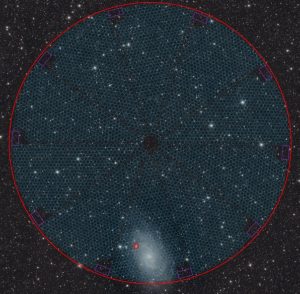
DESI’s 5000 spectroscopic “eyes” can cover an area of sky about 38 times larger than that of the full moon, as seen in this overlay of DESI’s focal plane on the night sky (top). Each one of these robotically controlled eyes can fix a fiber-optic cable on a single object to gather its light. Photo: DESI collaboration
The Dark Energy Spectroscopic Instrument seeks to further our cosmic understanding by creating the largest 3-D map of galaxies to date. Below is a press release issued by Lawrence Berkeley National Laboratory announcing first light for this extraordinary instrument. The U.S. Department of Energy’s Fermi National Accelerator Laboratory is a key player in the construction of this instrument, drawing on more than 25 years of experience with the Sloan Digital Sky Survey and the Dark Energy Survey.
Fermilab contributed key elements to DESI, including the corrector barrel, hexapod and cage. The corrector barrel – designed, built and initially tested at Fermilab – aligns DESI’s six large lenses to within the accuracy of the width of a human hair. This precision is essential to ensure that the images DESI collects are sharp and clear. The hexapod, designed and built with partners in Italy, moves and focuses the lenses. Both the barrel and hexapod are housed in the cage, which was also designed and built by Fermilab. Additionally, Fermilab carried out the testing and packaging of the charge-coupled devices, or CCDs. The CCDs convert the light passing through these lenses from distant galaxies into digital information that can then be analyzed by the collaboration.
Read more here.









